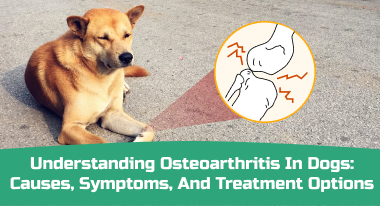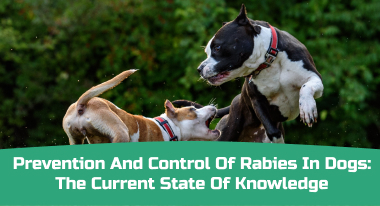Table of Contents
Distemper is a highly contagious viral disease caused by the canine distemper virus (CDV). It is highly infectious, and canines suffering from the ailment commonly exhibit systemic clinical signs such as fever, lethargy, loss of appetite, respiratory signs, and GI signs, variably followed by neurologic symptoms.
Dogs go through phases based on the time elapsed since their earliest exposure to the virus.
Distemper virus is ubiquitous in raccoons, skunks, and foxes. It’s also been seen in wildlife such as hyenas, weasels, badgers, otters, ferrets, mink, wolverines, and big cats.
Distemper can be transmitted in different ways — via airborne exposure, such as when droplets from an infected animal’s nose contaminate their environment, through direct exposure with an infected animal or the placenta.
The disease can lead to severe complications that affect your dog’s physical and mental health if left untreated. Read on to learn more about this distemper in dogs, its symptoms, its cause, and possible treatment options.
What Are The Signs And Symptoms Of Canine Distemper
Canines suffering from distemper experience a wide array of symptoms based on the disease’s advancement. During the initial phase, the virus replicates in the respiratory tract’s lymphatic tissue. In the advancement states, it moves through lymphatic tissue, the GI tract, the respiratory tract, the central nervous system, and optic nerves.
Distemper is transmitted mainly by respiratory secretions (coughing and sneezing). But also can be spread via food bowls and contaminated supplies and equipment. Irrespective of age, canines can contract distemper in dogs. Especially if your pet has not completed a core series of the DHPP vaccine, i.e., distemper, adenovirus-2, parainfluenza, and parvovirus vaccine are more susceptible to the disease.
Clinically, canine distemper is characterized as:
- A diphasic fever
- Respiratory discharge and pneumonia
- Diarrhea and inappetence
- Frequently, neurologic complications
The symptoms of canine distemper can be classified into two stages:
Stage One:
The first symptom of distemper in dogs starts with watery discharge from the eyes. And then, it is followed by other symptoms such as fever, loss of appetite, and clear nasal discharge. Fever is seen mostly up to 3-to-6 days after being infected. The severity of the symptoms depends on how the pet’s body reacts to them. A few of the signs of distemper in dogs during the initial stages of infection are:
- Fever
- Nasal and Eye discharge
- Lethargy
- Anorexia
- Coughing
- Pustular dermatitis
- Drooling
- Loss of coordination
- Losing teeth Enamel
- Brain and spinal cord inflammation
Often the pet infected with the distemper virus survives the acute stage of the illness, but after that, the pet may develop hyperkeratosis of the nose and paw pads. Among the other risks associated with distemper is a secondary bacterial infection causing respiratory and GI symptoms, such as:
- Vomiting and Diarrhea
- Difficulty in breathing
- Respiratory rate change
- Pneumonia
Stage Two:
Suffering canines also may develop neurological signs as the disease progresses. When the virus attacks the attacks central nervous system, you may witness signs such as
- Paresis to Paralysis
- Seizures
- Involuntary eye movements
- Head tilt
- Circling
- Muscle twitching
- Convulsions with increased salivation
- Chewing motions
- Death
Infographic
Often when the owner may not notice the sign of canine distemper. When infected, the pet can get a mild to severe case, and the pet also may have symptoms that only last ten days. The neurological symptoms may show up months after infection.
In cases of higher severity, even though the dogs survive usually are seen to have permanent, irreparable nervous system damage. To create more awareness in this regard here’s a visual illustration of the canine distemper signs:

| Canine Distemper: Signs and Symptoms The highly contagious paramyxovirus causes canine distemper. The disease affects dogs’ respiratory, gastrointestinal (GI), and nervous systems. Signs and symptoms of canine distemper include: #1 Nasal discharge The Initial signs include nasal discharge, coughing, and watery eyes. Fever is also a common sign during the early stage of the disease. #2 Gastrointestinal Difficulties The virus attacks the gastrointestinal tract, resulting in loss of appetite, vomiting, and diarrhea. The affected pet is lethargic, and the onset of symptoms of pneumonia also can be associated with distemper. #3 Muscle Twitching When the virus courses through the nervous system, involuntary muscle twitching is seen in the affected pet. It led to symptoms like weakness and complete paralysis of hind limbs, followed by non-functionality of all limbs. #4 Seizures Seizure is a serious sign of canine distemper. As the disease progresses, seizures become more frequent. Along with it, you also may witness cracked/thickened skin and behavioral changes. #5 Imbalanced Movements The neurological signs of distemper lead to uncontrolled and uncoordinated movements. You may witness the affected pet’s head tilted along with rapid eye movements. #6 Enhanced SensitivitiesIn the advanced stages of the disease, the affected pet may have an increased sensitivity to touch. Also, the pet becomes more sensitive to light and may experience eye discomfort. |
What are the Common Causes Of Distemper In Dogs?
A dog may get infected if the pet is in contact with infected blood, urine, blood, saliva, or respiratory droplets of an infected animal. Usually, the transmission of the virus happens via droplets, and it is spread through sneezing and coughing or contaminated food and water bowls or other equipment.
Canine distemper virus is resistant to cold, and the disease risk increases during the late fall and winter. A pet can get the virus if it is around the infected animal, and puppies or the geriatric canine that are not vaccinated are more vulnerable. Also, you should be careful in adopting pets from shelters as the vaccinations may not be up to date.
What are the Treatments for Distemper in Dog
Veterinarians diagnose the disease through clinical appearance and laboratory testing. Also, the vet may suggest tests to rule out conditions such as Rocky Mountain spotted fever, Contagious viral hepatitis, etc. To confirm ailment, reverse transcriptase PCR (RT-PCR) and antibody detection tests are used.
Your vet may take throat, nose, eye swabs, or urine or bone marrow samples, suggest testing blood or spinal fluid for antibodies, or take biopsies of the footpad to test for viral DNA.
As with most viral infections, antibiotics such as amoxicillin and ampicillin are used to control secondary bacterial infections. The treatment aims at reducing the intensity of signs and symptoms. Treatment also involves hospitalization to provide the pet with intensive nursing care, intravenous fluid therapy, and symptomatic treatment for vomiting, diarrhea, cough, etc. Anti-seizure medications, such as diazepam, are used in severe cases.
There is a precise cure for distemper in dogs diagonalizing for canine distemper infection. Dogs infected with canine distemper are protected from other dogs to minimize the risk of further disease.
Treatment includes:
- Administration of prophylactic broad-spectrum antimicrobials
- Balanced electrolyte solutions
- Parenteral nutrition
- Administration of antipyretics, analgesics, and anticonvulsants
- Nursing care
Unfortunately, treatment for acute neurologic manifestations of distemper is OFTEN unsuccessful. The owner should be appropriately advised if the neurologic signs are progressive or severe. With prompt, aggressive care, dogs may recover entirely from multisystemic clinical signs; in other cases, however, neurologic signs may persist after GI and respiratory signs have resolved. Some dogs with chronic progressive forms of the neurologic disease may respond to glucocorticoid therapy.
How To Prevent Canine Distemper?
Specific vaccines to prevent this deadly disease are provided to puppies along with other routine vaccines at eight weeks, twelve weeks, and six weeks of age. After the initial dose, take your puffball for additional distemper vaccine boosters that should be given to adult dogs. Consult your veterinarian will help determine how often your dog should receive a booster vaccine.
Also, based on the prevalence of canine distemper in the area, consult you to get a specific vaccine schedule along with that. Maintain a healthy diet and exercise program, maintain your pet’s hygiene routine, and clean your dog’s living area regularly. If you are frequently required to take your pet to a boarding kennel, ascertain the dog is vaccinated.
After vaccine administration, most dogs will not develop complete immunity until more than two weeks after initial vaccination, when they are given a second dose of vaccine. So stringently following with a booster vaccine 14 days later is key to preventing canine distemper transmission in the shelter setting.
Prevention Strategies
| Vaccination | DHPP vaccine i.e., distemper, adenovirus-2, parainfluenza, and parvovirus vaccine booster dose after 14 days |
| Sanitation | Maintaining a disinfecting schedule Ensuring clean water bowl, food bowl, and pet’s leaving area regularly. Using PPE Kit for pets in high-risk areas |
| Animal Movement | Quarantine infected dogs during outbreakTest at the end of 14 days of QuarantineIsolation and serial PCR testing for pets consider no longer contaminated |
Conclusion
Dogs infected with distemper even after the cure, develop lifelong debilitating nervous system issues. Compared to adult dogs and puppies. The disease tends to be fatal in puppies. The ailment also Distemper can cause long-lasting seizures and chronic severe pneumonia
To prevent the disease, avoid gaps in the immunization schedule. When you take your pet for socializing puppies puppy classes, obedience classes, or doggy day care be careful also if you have pets such as ensure to vaccinate them with the USDA-approved ferret vaccine.
Disclaimer: The content on the site is for educational purposes only, and it does not provide medical advice. The shared information must not be treated as a substitute for or alternative for medical practitioner advice, diagnosis, or treatment. Regarding any concerns about your pet’s health, seeking veterinary guidance is of utmost necessity. Each pet has specific health, fitness & nutrition needs. Do not disregard, avoid or delay pet health-related advice from veterinarians based on reading the information provided on this site.
FAQs
How Frequently has Distemper seen in Dogs?
Canine Distemper is seen worldwide, but compared to the earlier years, it is less. But the ailment is seen mostly where the vaccination rates are low.
How Is Distemper Spread In Dogs?
The ailment can spread by droplets of body fluids. The ailment can also be spread through air breathed out by an infected dog. The virus does not survive in the environment, and most disinfectants can kill it. But suffering dogs can shed the virus for days, weeks, or sometimes months after contracting it.
What is the Percentage Of Dogs Surviving Distemper?
The disease is fatal, with a mortality rate of 50% in adult dogs. And the mortality rate is even higher, with 80% in puppies. Any unvaccinated canine is at risk of Distemper.
Is Distemper Similar To Parvo?
Canine Distemper and Parvo are different diseases. But both ailments are highly contagious viral diseases that can cause severe symptoms and even death. Distemper in dogs attacks the nervous, lymph, and epithelial systems, whereas parvo mainly targets the gastrointestinal tract.



